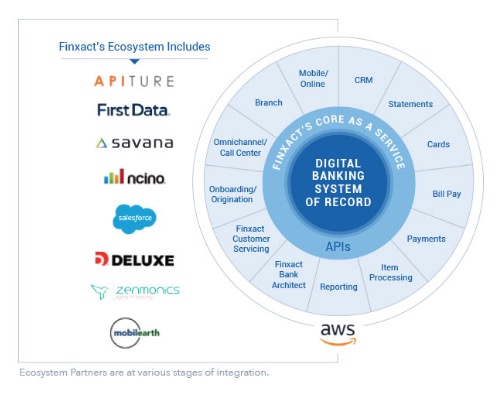Jacksonville, Florida-based SaaS core banking company Finxact has raised $30 million in equity funding from new and existing investors. American Bankers Association (ABA), Accenture Ventures, SunTrust Bank, and other strategic industry leaders were new investors in this round. Finxact’s existing investors Live Oak Ventures, First Data, Woodforest National Bank, and T.N. Incorporation Ltd (TNI) of Thailand also invested in this round.
With this round of funding, Finxact will complete development and build scale to match the market’s demand for a new category of core banking platform. And Finxact’s Core as a Service represents a first of a kind option for banks to differentiate customer experiences by seamlessly integrating new services and migrating to a real-time digital banking enabled system of record.
“We started Finxact in the beginning of 2017, and we have focused on building a banking system of record that can effectively replace legacy core systems and also serve as a platform for rapidly evolving digital banking requirements,” said Finxact CEO and founder Frank Sanchez. “We’ve developed a platform that is functionally robust, reliable, scalable and highly efficient. We have multiple customer implementations currently underway and have raised capital to expand our capacity to go to market on a broader scale. We also plan to expand our integration activities with the financial services ecosystem and to mitigate the risk and complexity historically associated with core system migrations.”

One of the biggest problems that Finxact is planning to solve is helping banks move on from antiquated high-cost systems and the inability to react to rapidly evolving customer demands. Finxact and the company’s partners share a vision to provide transformative solutions for every bank and to deliver a new category of banking platform.
“Bankers know that innovation is essential to remaining competitive, yet I’ve heard time and again that their relationship with their core provider can make it difficult to be agile in selecting products and partners,” added ABA President and CEO Rob Nichols. “We are confident that the impressive team at Finxact will challenge the entire industry, including banks and their providers, to think differently about the way a core platform enables a bank to innovate.”
Finxact’s core banking platform provides the industry with a regulatory compliant system of record for processing core banking transactions. And the company’s partners and customers now have a platform for quickly creating new customer experiences and services using a highly accessible and customizable platform.
“The core banking market in the U.S. is set to experience significant disruption in the near future, as banks continue to grow frustrated with their existing core providers and advances in cloud and digital technology make it possible to upgrade aging systems without doing a full rip and replace,” explained Brett Goode — who is a managing director at Accenture and head if the company’s North America Core Banking Practice. “We are pleased to invest in and form a strategic alliance with Finxact, enabling us to jointly bring our clients innovation that will help them transform to meet the digital needs of today and tomorrow.”
Live Oak Bancshares Chairman and CEO Chip Mahan said that Finxact provides the technology and data that today’s financial institutions need to succeed in a modern world. And First Data EVP Chris Foskett pointed out that Finxact has made “great strides in redefining what core processing is, how it is delivered, bolstering the value it drives for banks and consumers.”
“The Finxact core is designed to address the entire marketplace from community banks and credit unions to the largest money center banks,” Finxact president Michael Sanchez commented. “As we transition from our initial development phase to market delivery, we are working with our service partners in each segment to develop a new set of best practices that not only reduce the risk of transformation but also the implementation cycle time.”


